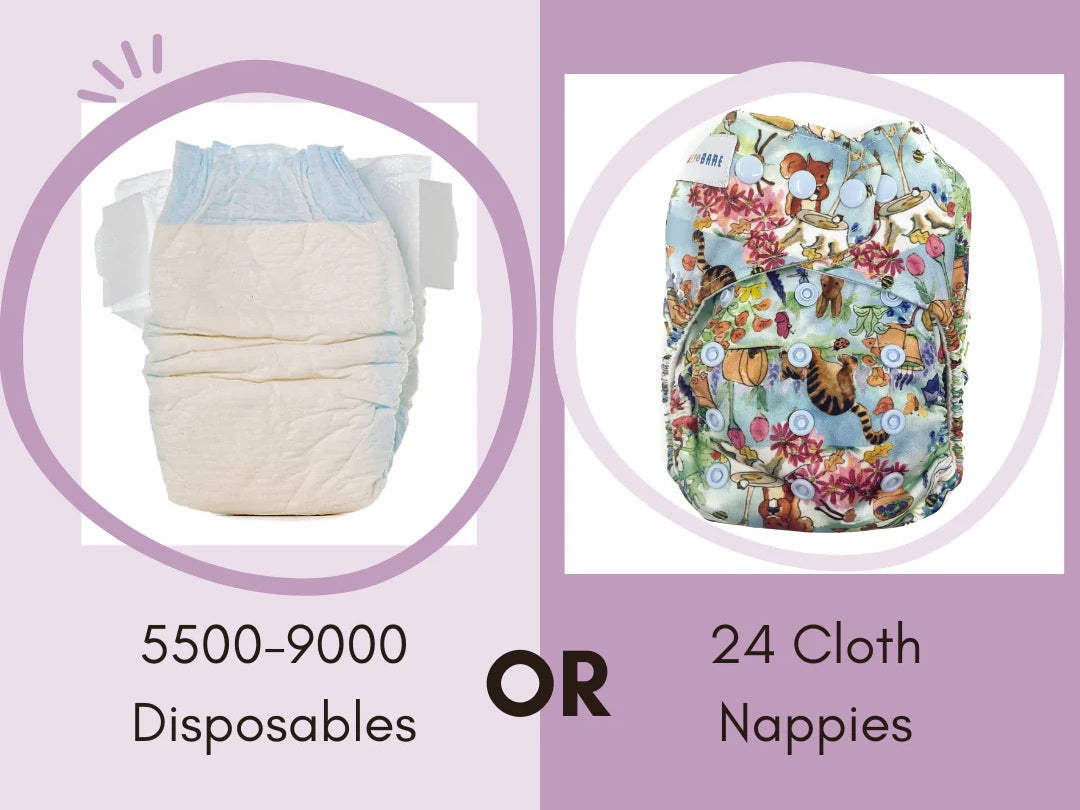For many UK parents, finding ways to save money on baby essentials is a priority. From clothes to toys and, especially, nappies, the costs can quickly add up. But what if there was a solution that’s budget-friendly, eco-friendly, and better for your baby’s skin? Cloth nappies might be the answer you’re looking for! While the initial investment can seem a little higher, the savings over time are substantial. In this guide, we’ll walk through how cloth nappies save you money, tips for getting started, and how to make cloth nappy care easy.
1. Cloth Nappies vs. Disposable: Understanding the Savings
The average UK baby goes through about 5,500-9,000 disposable nappies from birth to potty training. With nappies costing between 10–25p each, parents can end up spending anywhere from £400 to £1,500 on disposables alone.
In comparison, a full set of reusable cloth nappies can cost between £200 and £500, depending on the brands and styles you choose. Since these nappies are washable and reusable, they only need to be purchased once, which can significantly cut down on overall nappy costs. For parents of multiple children, the savings multiply, as cloth nappies can be reused for each new baby with minimal additional expense.
2. How Cloth Nappies Help You Save Over Time
The long-term savings with cloth nappies come from a few key areas:
Lower Purchase Frequency: With disposable nappies, parents must continuously restock. Cloth nappies, however, are a one-time investment.
Reduced Waste Costs: Some councils in the UK charge for extra waste collection, and disposable nappies add a significant amount to weekly household waste. Switching to cloth nappies can reduce waste, potentially lowering or even eliminating extra waste collection costs.
Reusable with Other Children: Cloth nappies are durable enough to last for multiple children. The upfront investment you make with your first child can pay off again with subsequent babies, offering even more savings.
3. Where to Buy Affordable Cloth Nappies in the UK
Finding high-quality, affordable cloth nappies in the UK is easier than ever.
Bundle Discounts: We offer multi-buy discounts when you buy a set of cloth nappies, which reduces the initial cost per nappy.
Secondhand Options: Pre-loved cloth nappies are widely available on UK online marketplaces. Groups on Facebook and other community forums allow parents to buy, sell, or swap gently used cloth nappies, providing an even more affordable entry into cloth nappy use.
Local Council Schemes: Some councils in the UK offer cloth nappy incentives, including starter packs or discounts, to encourage eco-friendly parenting. Check with your local council to see if they offer support for families interested in cloth nappies.
And this Black Friday, you can save even more! We're offering exclusive discounts during Black Friday (click here), making it the perfect time to stock up on everything you need at a fraction of the price. Dive into the world of cloth nappies this season and enjoy a cleaner, greener, and more budget-friendly way to care for your baby!
4. Cost-Effective Cloth Nappy Care and Maintenance Tips
One of the biggest concerns for parents new to cloth nappies is the cost of washing them. But with a few efficient practices, washing costs can stay low:
Wash Efficiently: A quick rinse followed by a full wash at 40°C is usually enough to clean cloth nappies thoroughly. Avoid higher temperatures, which can wear out the nappies faster and consume more energy.
Air Drying: Instead of tumble drying, which can consume a lot of electricity, air-dry nappies whenever possible. Not only does this reduce costs, but it also extends the life of the nappies.
Use Cloth Wipes: Disposable wipes can also add up in cost, and using cloth wipes along with cloth nappies can save even more. Cloth wipes can be washed along with the nappies, reducing waste and costs.
5. Additional Benefits of Cloth Nappies
While saving money is a big benefit, cloth nappies offer several other perks that parents love:
Eco-Friendly: Disposable nappies take hundreds of years to decompose and contribute significantly to landfill waste. Switching to cloth nappies can help reduce your family’s environmental footprint.
Gentle on Baby’s Skin: Cloth nappies are often made with soft, natural fabrics that can be gentler on your baby’s skin, potentially reducing the risk of rashes and irritation.
Stylish Designs: Today’s cloth nappies come in various colours, patterns, and styles, making them a cute addition to your baby’s wardrobe.
6. Getting Started with Cloth Nappies: A Few Tips for New Parents
If you’re new to cloth nappies, here are some tips to help you make a smooth transition:
Start Slowly: Try using cloth nappies part-time initially to get used to the routine. This can also help you decide which styles and brands work best for your baby.
Explore Different Types: Cloth nappies come in different styles, including all-in-ones, pocket nappies, and two-part systems. Experiment with different types to find what’s most convenient for you.
Seek Community Support: There are plenty of online communities and local parenting groups that can offer advice, tips, and support as you get started with cloth nappies.
Conclusion
Switching to cloth nappies is a smart financial choice for UK parents looking to save money on baby essentials. The initial investment quickly pays off, especially if you plan to use them for multiple children. With affordable washing practices, high-quality secondhand options, and available discounts, cloth nappies are more accessible than ever before. Plus, with the added benefits for your baby’s skin and the environment, cloth nappies are a win-win.
Ready to start saving? Dive into the world of cloth nappies and enjoy a cleaner, greener, and more budget-friendly way to care for your baby!

